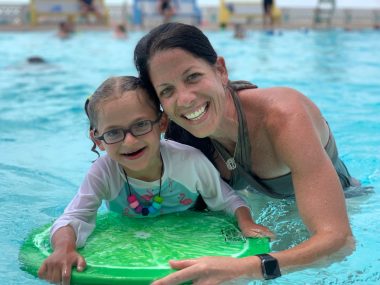Nonprofit FAST Has Cure for Angelman Syndrome in Its Sights
Following GeneTx acquisition, organization continues funding treatment research
Written by |

John Schlueter poses for a photo with his family, from left: Jack, Ella, Sarah, Bethany, Grace, John, and Max. (Photo courtesy of John Schlueter)
Note: This story was updated Oct. 26, 2022, to correct that John Schlueter became a member of the Foundation for Angelman Therapeutics board months after learning about the foundation. It’s also been corrected to note that the investigational treatment GTX-102 targets and inhibits the molecule that keeps the paternal copy of the UBE3A gene from being active in cells, and that FAST is not currently funding an antisense oligonucleotide project. Lastly, the story has been corrected to note that the Schlueter family prefers to travel by car on vacations.
John Schlueter attended his first Foundation for Angelman Therapeutics (FAST) gala in December 2015. It changed his life.
Schlueter had just learned that his second child, Grace, had been diagnosed with Angelman syndrome, a complex neurological genetic disorder that affects about one in 15,000 people. But this 600-person event gave him hope and a greater purpose.
“I got into this because of Grace but also because of the thought of being a very small part of the cure for 500,000 people, and then caregivers, whose lives are greatly impacted by Angelman syndrome, as well,” Schlueter, now the chairman of the foundation’s board of directors, said. “It’s certainly over a million people who will have a more independent life with a cure.”
Since its founding in 2008, the nonprofit has been funding a number of research pathways for disease-altering treatments for the condition, which can typically cause balance issues, motor impairment, and seizures.

John Schlueter with his daughter, Grace, who has Angelman syndrome, on her first day of kindergarten. (Courtesy of Foundation for Angelman Therapeutics)
Within months of learning about FAST, Schlueter became a member of its board. Around two years later, FAST started the company GeneTx, which developed the investigational treatment GTX-102 that targets and inhibits the molecule that keeps the paternal copy of the UBE3A gene from being active in cells. GeneTx was acquired by Ultragenyx in July for $75 million, with FAST having majority ownership.
A Phase 1/2 study (NCT04259281) is underway to evaluate the safety and tolerability of GTX-102. Ultragenyx announced this summer that interim data showed GTX-102 could improve function among children and adolescents with Angelman, and was well-tolerated.
The funds raised by GeneTx’s acquisition and through general fundraising are being invested back into research and clinical development for other treatments vetted by FAST.
Many paths to an Angelman syndrome cure
The organization also is funding work in microRNA, enzyme replacement therapy, and gene-editing tool CRISPR across genetic variants, including deletions, mutations, and other chromosomal defects.
For Schlueter and the organization, these efforts underscore the importance of finding a cure using more than one approach.
Allyson Berent, chief science officer, and former chief operating officer at GeneTx, said the need for approved treatments was what led to creating GeneTx. GTX-102 showed promise and FAST’s goal was to move the treatment through toxicology and pharmacology stages so that it would appeal to investment from a larger company.
“We really thought about how we can get the work that we had so hugely funded for so many years out of the academic lab, ensure that it didn’t hit the valley of death, and that it really got to a human candidate, and that we could de-risk it,” said Berent, who has an 8-year-old daughter with Angelman syndrome.
FAST doesn’t plan on putting all of its eggs in one basket, but plans, instead, to fund myriad approaches that could show clinical benefits in patients. The group is funding research in 10 platforms, such as adeno-associated virus (AAV) gene therapy, hematopoietic stem cell gene replacement therapy, CRISPR Cas 9 and Cas 13, and enzyme replacement therapy, Berent said.
The organization is currently funding a gene replacement study at the University of Pennsylvania and artificial transcription factors at the University of California, Davis.
A gift of Grace
Schlueter shares Berent’s focus on exploring multiple avenues to find a cure for Angelman syndrome.
He said Angelman has drastically changed his life since he and his wife, Bethany, first suspected something wasn’t right with Grace, who wasn’t diagnosed until she was 2 after repeated requests by the couple for Schlueter to undergo genetic testing. As early as 6 months, doctors had been telling the couple Grace was merely behind developmentally, Schlueter said.

Allyson Berent and her daughter, Quincy, 8, play in a pool. (Courtesy of Allyson Berent)
As part of their journey to learn more about the disease, Schlueter and his wife met another family with a daughter just a few years older than Grace. That family said the Schlueters reminded them of “FAST parents” who would do whatever it took to help their daughter and invited them to that 2015 gala.
The Schlueters, who live in Milwaukee, have five children, ranging in age from 4 to 10, and having an Angelman child is challenging, they admit.
Neither Schlueter nor any other board member is paid for their work with FAST. To pay the bills, Schlueter works a full-time job manufacturing textile products and developing and leasing commercial real estate.
Grace is unable to speak, a common symptom of the condition. Visiting family can be overwhelming for Grace, so they typically invite relatives to their house. When they do visit others, they have to leave early, which is especially rough on the younger kids, Schlueter said.
Grace requires 24/7 care so a person was hired to care for her and the other children during the weekdays. At night and on the weekends, Schlueter and Bethany Schlueter are on their own.
Even with the challenges, Schlueter is grateful for Grace and everything she brings to his family. It’s made his able-bodied children more thoughtful and inclusive, he said.
“Grace is a blessing to our entire family,” Schlueter said. “I like to think I’m not just a better dad, but a better person. Because I’m blessed to be Grace’s dad.”
Schlueter describes Grace as joyous and said she plays with her friends as any other 9-year-old would.
She loves being in a pool, though she can’t swim. Schlueter holds her while she plays with the jets. Recently, her friend from school, Lily, came over to play with her, and, even though Grace doesn’t talk, they still communicated and enjoyed each other’s company.
“Grace’s only response is a joyous smile and laughter,” Schlueter said. “You could physically see in her whole body how excited she was to see Lily after six or eight weeks.”
Looking forward to an Angelman cure, and more
Schlueter is looking toward the future as organizations such as FAST fund projects that could eventually lead to treatments in the clinic. Even with multiple therapies in development, having an accurate diagnosis and a strong disease community is equally important, same as it is with many rare diseases.
“For our family, I can say that diagnosis was enormous. Not only the therapy, as big as that was, but the community. I’m so grateful for the community,” he said.
FAST is also looking at a number of nonresearch pathways to help patients, including developing better biomarkers and endpoints, promoting newborn screenings, and establishing a global registry to identify patients who might not be counted. If a treatment is approved, FAST is focused on ensuring access for all patients.
“If you can’t get them to patients, then you haven’t done a service to the community,” Schlueter said. “We are very, very strongly invested in making sure that we can help the entire lifecycle of drug development, which includes diagnosis, policy, endpoints, biomarkers, education, advocacy, and identification.”
When Schlueter walked into that first FAST gala, he saw 600 people pledging money to next-generation science to treat Angelman. The gala was preceded by a two-day scientific conference where he learned about all the avenues FAST is exploring.
“We want a cure for every single person living with Angelman syndrome,” Schlueter said. “A cure for every genotype, so every family can have the hope we have now and even more hope when they’re newly diagnosed.”
To do that, FAST needs to fund as much diverse science as it can.
“Multiple shots on goal is what every child needs and deserves,” he said.





